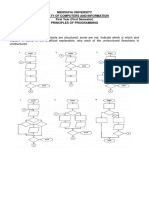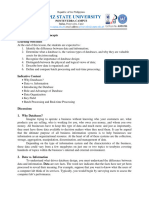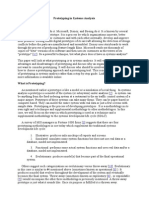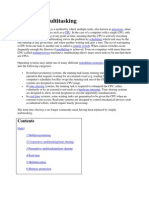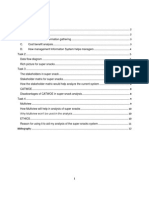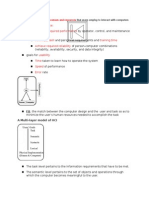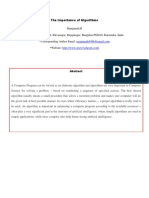Basic Computer Science
Uploaded by
neenu1Basic Computer Science
Uploaded by
neenu1Neenu Prasad
Input
Memory Output
Arithmetic and logic
Control
I/O
Processor
Figure 1.1. Basic functional units of a computer.
Input unit : receive both data and program statements to function properly and be able to solve problems feeding data and programs Eg: keyboard, a mouse, or a scanner
Store programs and data Two classes of storage
Primary storage
Fast Programs must be stored in memory while they are being executed Large number of semiconductor storage cells Processed in words Address RAM and memory access time Memory hierarchy cache, main memory
Secondary storage larger and cheaper
The brain of a computer system is the central processing unit (CPU). computing center of the system processes data transferred to it from one of the various input devices consists of a control section, an arithmeticlogic section and an internal storage section
Most computer operations are executed in ALU. Performs all arithmetic calculations and take logical decisions. Tests various conditions encountered during processing and takes action based on the result
All computer operations are controlled by the control unit.
The control section directs the flow of traffic (operations) and data. It also maintains order within the computer
Operations of a computer:
Accept information in the form of programs and data through an input unit and store it in the memory Fetch the information stored in the memory, under program control, into an ALU, where the information is processed Output the processed information through an output unit Control all activities inside the machine through a control unit
convert information coming from a computer system into some form perceptible by humans Eg:Monitor
You might also like
- Module 3 - Computer Programming Development - Problem SolvingNo ratings yetModule 3 - Computer Programming Development - Problem Solving77 pages
- 1.introduction To Management Information Systems-LuceyNo ratings yet1.introduction To Management Information Systems-Lucey8 pages
- Menoufia University Faculty of Computers and Information First Year (First Semester) Principles of ProgrammingNo ratings yetMenoufia University Faculty of Computers and Information First Year (First Semester) Principles of Programming7 pages
- Components of The Computerized System: I. HardwareNo ratings yetComponents of The Computerized System: I. Hardware6 pages
- 02-Understanding The Programming ProcessNo ratings yet02-Understanding The Programming Process34 pages
- Introduction To Computing: What Is A Computer?No ratings yetIntroduction To Computing: What Is A Computer?11 pages
- Introduction To Computer Hardware Final ExamsNo ratings yetIntroduction To Computer Hardware Final Exams7 pages
- Worksheets: 1. Categorize The Following Uses of Computers. Two Categories Are Given Below, Fill in The Third Category50% (2)Worksheets: 1. Categorize The Following Uses of Computers. Two Categories Are Given Below, Fill in The Third Category4 pages
- Ict2203 Computer Application Software SSSFTNo ratings yetIct2203 Computer Application Software SSSFT4 pages
- Keyboard Processing With Control Flow: Julius BancudNo ratings yetKeyboard Processing With Control Flow: Julius Bancud30 pages
- Introduction To Information Communication Technology: Chapter One An Overview of IT and Data Processing100% (1)Introduction To Information Communication Technology: Chapter One An Overview of IT and Data Processing19 pages
- Chapter One (1) : Introduction To Information Technology (It)100% (2)Chapter One (1) : Introduction To Information Technology (It)109 pages
- Lesson 1-Introduction To Enterprise Systems For ManagementNo ratings yetLesson 1-Introduction To Enterprise Systems For Management17 pages
- Chapter 2 - Processes in Conducting ResearchNo ratings yetChapter 2 - Processes in Conducting Research38 pages
- Lecture 1-Fundamentals of Information SystemsNo ratings yetLecture 1-Fundamentals of Information Systems31 pages
- Computer Science Notes OBJECTIVE Chapter 1 Class XINo ratings yetComputer Science Notes OBJECTIVE Chapter 1 Class XI22 pages
- 01 ELMS Activity 1 (In Computer Engineering As A Discipline)No ratings yet01 ELMS Activity 1 (In Computer Engineering As A Discipline)1 page
- Lecture 01 - Computer Hardware and Software ArchitecturesNo ratings yetLecture 01 - Computer Hardware and Software Architectures67 pages
- Software Engineering Lab - CSE342P Experiment ListNo ratings yetSoftware Engineering Lab - CSE342P Experiment List2 pages
- Computer Concepts For Commerce: WWW - Isat.guru WWW - Raghug.inNo ratings yetComputer Concepts For Commerce: WWW - Isat.guru WWW - Raghug.in112 pages
- Chapter I - The Database Environment and Development Process50% (2)Chapter I - The Database Environment and Development Process14 pages





